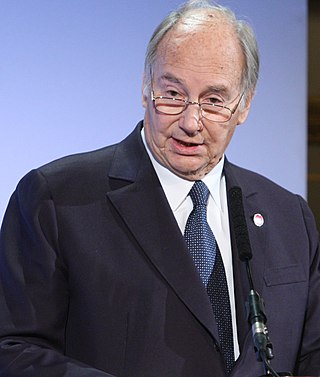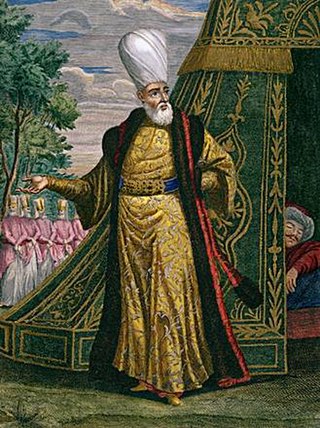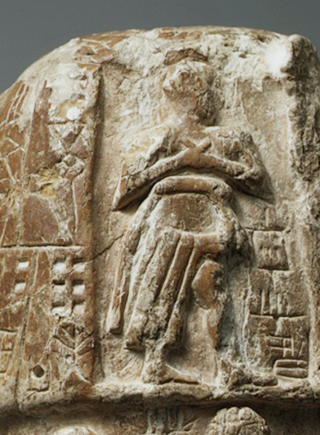
Sir Sultan Mahomed Shah, known as Aga Khan III, was the 48th imam of the Nizari Ism'aili branch of Shia Islam. He was one of the founders and the first permanent president of the All-India Muslim League (AIML). His goal was the advancement of Muslim agendas and the protection of Muslim rights in British India. The League, until the late 1930s, was not a large organisation but represented landed and commercial Muslim interests as well as advocating for British education during the British Raj. There were similarities in Aga Khan's views on education with those of other Muslim social reformers, but the scholar Shenila Khoja-Moolji argues that he also expressed a distinct interest in advancing women's education for women themselves. Aga Khan called on the British Raj to consider Muslims to be a separate nation within India, the famous 'Two Nation Theory'. Even after he resigned as president of the AIML in 1912, he still exerted a major influence on its policies and agendas. He was nominated to represent India at the League of Nations in 1932 and served as President of the 18th Assembly of The League of Nations (1937–1938).

Nils Gustaf Dalén was a Swedish engineer, industrialist, long-term CEO of the AGA company and inventor of the AGA cooker and the Dalén light. In 1912, he was awarded the Nobel Prize in Physics for his "invention of automatic regulators for use in conjunction with gas accumulators for illuminating lighthouses and buoys".

The Aga Range Cooker is a Swedish range cooker. Invented and initially produced in Sweden, since 1957 most production has been located in the UK. In 2015, the British AGA Cooker manufacturing company, AGA Rangemaster Group, was acquired by the American corporation Middleby.
Amiga Advanced Graphics Architecture (AGA) is the third-generation Amiga graphic chipset, first used in the Amiga 4000 in 1992. Before release AGA was codenamed Pandora by Commodore International.

Aga Khan is a title held by the Imām of the Nizari Ismāʿīli Shias. Since 1957, the holder of the title has been the 49th Imām, Prince Shah Karim al-Husseini, Aga Khan IV. Aga Khan claims to be a direct descendant of Muhammad, the last prophet according to the religion of Islam.

Prince Karim Al-Husseini, known as the Aga Khan IV since the death of his grandfather in 1957, is the 49th and current imam of Nizari Isma'ilis. He has held the position of Imam and the title of Aga Khan since 11 July 1957 when, at the age of 20, he succeeded his grandfather, Aga Khan III. The Aga Khan claims direct lineal descent from the Islamic prophet Muhammad through Muhammad's cousin and son-in-law, Ali, who is considered an Imam by Nizari Isma'ilis, and Ali's wife Fatima, Muhammad's daughter from his first marriage. Aga Khan IV is also known by the religious title Mawlānā Hazar Imam by his Isma'ili followers.
Nizari Isma'ilism are the largest segment of the Ismaili Muslims, who are the second-largest branch of Shia Islam after the Twelvers. Nizari teachings emphasize independent reasoning or ijtihad; pluralism—the acceptance of racial, ethnic, cultural and inter-religious differences; and social justice. Nizaris, along with Twelvers, adhere to the Jaʽfari school of jurisprudence. The Aga Khan, currently Aga Khan IV, is the spiritual leader and Imam of the Nizaris. The global seat of the Ismaili Imamate is in Lisbon, Portugal.

The Aga Khan Award for Architecture (AKAA) is an architectural prize established by Aga Khan IV in 1977. It aims to identify and reward architectural concepts that successfully address the needs and aspirations of Muslim societies in the fields of contemporary design, social housing, community development and improvement, restoration, reuse and area conservation, as well as landscape design and improvement of the environment.

Jamatkhana or Jamat Khana is an amalgamation derived from the Arabic word jama‘a (gathering) and the Persian word khana. It is a term used by some Muslim communities around the world, particularly sufi ones, to a place of gathering. Among some communities of Muslims, the term is often used interchangeably with the Arabic word musallah. The Nizārī Ismā'īlī community uses the term Jama'at Khana to denote their places of worship.

The Aga Khan Development Network (AKDN) is a network of private, non-denominational development agencies founded by the Aga Khan, with the primary focus of improving the quality of life in different regions of Asia and Africa.

The Aga Khan University Hospital (AKUH) in Karachi, established in 1985, is the primary teaching site of the Aga Khan University's (AKU) Faculty of Health Sciences. Founded by the Aga Khan, the hospital provides a broad range of secondary and tertiary care, including diagnosis of disease and team management of patient care.

Aga Khan University is a not-for-profit institution and an agency of the Aga Khan Development Network. It was founded in 1983 as Pakistan's first private university. Starting in 2000, the university expanded to Kenya, Tanzania, Uganda, the United Kingdom and Afghanistan.

Agha is an honorific title for a civilian or officer, or often part of such title. In the Ottoman times, some court functionaries and leaders of organizations like bazaar or the janissary units were entitled to the agha title. In rural communities, this term is used for people who own considerable lands and are influential in their community. Regardless of a rural community, this title is also used for any man who is influential or respected.

AGA Rangemaster is a British manufacturer of range cookers, kitchen appliances, and interior furnishings owned by Middleby Corporation in September 2015 after it received a takeover approach from Whirlpool. It employs just over 2,500 people worldwide. AGA stands for Aktiebolaget Gas Accumulator.

The Aga Khan Palace was built by Sultan Muhammed Shah Aga Khan III in the city of Pune, India.

Archnet is a collaborative digital humanities project focused on Islamic architecture and the built environment of Muslim societies. Conceptualized in 1998 and originally developed at the MIT School of Architecture and Planning in co-operation with the Aga Khan Trust for Culture. It has been maintained by the Aga Khan Documentation Center at MIT and the Aga Khan Trust for Culture since 2011.

The Aga Khan Museum is a museum of Islamic art located at 77 Wynford Drive in the North York district of Toronto, Ontario, Canada. The museum is dedicated to Islamic art and objects, and it houses approximately 1,200 rare objects assembled by Shah Karim al-Husayni and Prince Sadruddin Aga Khan. As an initiative of the Aga Khan Trust for Culture, an agency of the Aga Khan Development Network, the museum is dedicated to sparking wonder, curiosity, and understanding of Muslim cultures and their connection with other cultures through the arts. In addition to the Permanent Collection, the Aga Khan Museum features several temporary exhibitions each year that respond to current scholarship, emerging themes, and new artistic developments. The Museum Collection and exhibitions are complemented by educational programs and performing arts events.

Aga commonly known as Aga of Kish, was the twenty-third and last king in the first dynasty of Kish during the Early Dynastic I period. He is listed in the Sumerian King List and many sources as the son of Enmebaragesi. The Kishite king ruled the city at its peak, probably reaching beyond the territory of Kish, including Umma and Zabala.

Anu Aga is an Indian billionaire businesswoman and social worker who led Thermax, an energy and environment engineering business, as its chairperson from 1996 to 2004. She was among the eight richest Indian women, and in 2007 was part of 40 richest Indians by net worth according to Forbes magazine. She was awarded with the Mumbai Women of the Decade Achievers Award by ALL Ladies League, the all ladies wing of ASSOCHAM.
Aga Khan University Hospital, Kampala, is a hospital under construction in Uganda. It is an urban, tertiary, referral and teaching hospital whose planned construction will last five years, starting in 2020. It will be built in two phases. The first phase will consist of 150 beds at an estimated cost of US$100 million. The bed capacity will be increased to 600 during the second phase.
















